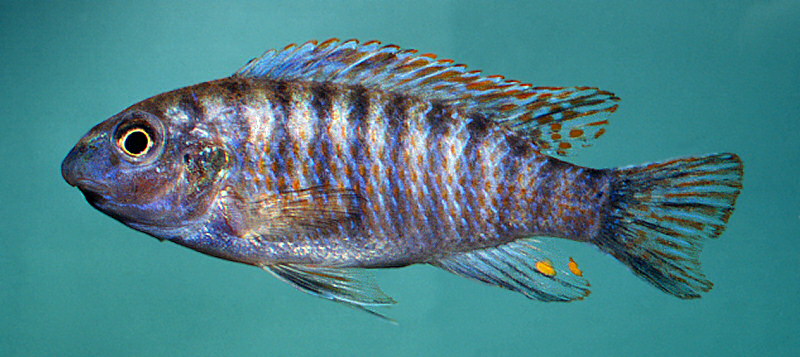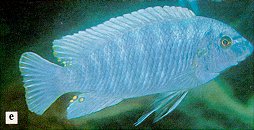

Above: A male Labeotropheus fuelleborni, photographed soon after being seined 10 August 1971 by M.K. Oliver and D.H. Eccles below the light on Thumbi Island East in Monkey Bay, Malawi. (The same seine haul caught more than 30 Melanochromis auratus and 18 individuals of the species I would later name Otopharynx lithobates.) Photo © by M.K. Oliver. It is an unusually colored male, which has the distinctvertical bars of the standard BB (black-barred blue) morph (like the fish in the small photo at left), but also has an orange spot in each flank scale, a speckled dorsal fin, and colorful orange rays in the caudal fin. (A piece has been bitten from the edge of the caudal fin — most likely by a Genyochromis mento.) Perhaps the individual in the above photo has partial OB (orange blotch) genes; certainly, it does not fit comfortably in any recognized major color morph.

Labeotropheus fuelleborni, standard barred
blue or BB morph, photographed underwater
at Mara Rocks, off Usisya, Malawi. Photo
from Plate 11e of Ribbink et al. (1983);
reproduced by permission of the Zoological
Society of Southern Africa.
L. fuelleborni is one of the most common and widely distributed members of the Mbuna species flock in Lake Malawi, occurring on most rocky shores. Individuals inhabit shallow water — rarely deeper than 20 meters (about 65 feet), and usually less than 10 meters (about 30 feet). Even within this depth range, they are much more abundant in the upper half, with immature individuals, females, and nonterritorial males concentrated in extremely shallow water (Ribbink et al., 1983).
In comparison to its sister species, L. trewavasae, L. fuelleborni is noticeably deeper bodied. This is the easiest way to distinguish the two species.
Members of the genus Labeotropheus can be recognized immediately by the overhanging, fleshy snout, with the jaws opening below and behind it. The straight toothbands, extending from side to side across the bottom of the head, are specialized for efficient cropping of the algae that grow on rocks. The genus was named because of the resemblance of the mouth to that in minnows of the genus Labeo.
Ribbink et al. (1983) have made interesting observations about the feeding behavior of L. fuelleborni:
"Non-territorial fish feed from the upper surfaces of rocks, and by virtue of their ventrally directed jaws they are able to feed in water which would be too shallow for fishes of a similar size, but which feed at right angles to the rock surface. Furthermore, since L. fuelleborni individuals feed parallel to the rock surface it appears that they are better able to cope with the turbulence which prevails in the extreme shallows than fishes which feed at right angles to the rock face. They favour the upper surfaces of rocks as feeding sites and have a varied diet which comprises mainly loose Aufwuchs, C1, C2 [these are two of the main types of filamentous algae], benthic Invertebrata and plankton...."Concerning the possible trophic function of the distinctive fleshy "nose" in species of Labeotropheus, Konings (1995c) reports the following:
"Both nose and chin are callused, probably as a result of continuous contact with rough substrates during feeding. The effect of the fish closing its mouth on the firmly-attached filamentous algae is to pull it closer to the substrate, and the nose then functions as a fulcrum, allowing its owner to shear off the algae by leverage rather than energy-consuming jerking of the body. This not only saves energy but also allows Labeotropheus to remain in close contact with the rocks, thus reducing the risk of being swept away by the turbulent water. Moreover it allows greater quantities of, and more tightly attached, algae to be cropped using the three or more rows of tricuspid teeth in the outer jaws; this feeding method is so efficient that the algae is removed completely, leaving visible scrape marks in the biocover."Male and female L. fuelleborni attain a total length of around 18 cm (7 inches). Although the species account in FishBase attributes a maximum standard length (excluding caudal fin) of 30 cm (12 inches) to this species based on Jackson (1961), Jackson makes no such outlandish claim. Heavily fed captive specimens, however, can get substantially larger than wild individuals.
Reproductive behavior in Labeotropheus was summarized by Konings (1995c):
"...Labeotropheus is unusual among mbuna. It is known from observations in captivity that the eggs are sometimes fertilised outside the female's mouth (Trewavas & Konings, 1992)! After the female has deposited a few eggs, the male, following behind her, fertilises them on the substrate. The female, meanwhile, describes a large circle, then collects the eggs on her next spawning pass, immediately before depositing the next batch. The fry, which are released for the first time after three works, find refuge inside the female's mouth for at least another week (Schönen, 1979). The egg-spots in the male's anal fin are proportionally the smallest (compared to the adult size of the fish) found in mbuna whereas the eggs are among the largest!"In the aquarium, it is important to provide enough room — 200 liters or 55 gallons is a bare minimum. (Guidance in selecting the optimum sized aquarium for this and other fishes can be found here.) Plenty of large rocks should be provided and allowed to develop a cover of algae. This diet can be supplemented with nori (dried seaweed), flake or pelleted food, and only occasionally with live or frozen daphnia, brine shrimp, or bloodworms; the diet must be predominantly vegetable to promote health and avoid predisposing the fish to "Malawi bloat." Avoid keeping L. fuelleborni with L. trewavasae because they easily hybridize in captivity.
The common name "Blue mbuna" is sometimes applied to L. fuelleborni but this is a very poor choice, since many of them are not blue, and at least the males of many other mbuna species are also blue.
Notable scientific work on this abundant and easily identified species includes that of Albertson & Kocher (2001) on jaw and neurocranial morphology; Arnegard et al. (1999) on population structure and color variation; Balon (1977) on early development; Fryer (1959a), Ribbink et al. (1983), and Duponchelle et al. (2000d) on ecology; Hale (1997) on feeding angle; Kornfield & Parker (1997) on microsatellite markers in nuclear DNA; and McElroy & Kornfield (1993) on jaw morphology in hybrids with Maylandia (Pseudotropheus) zebra.

| Last Update: 1 June 2008
Web Author: M. K. Oliver, Ph.D. Copyright © 1997-2021 by M. K. Oliver, Ph.D. - ALL RIGHTS RESERVED |